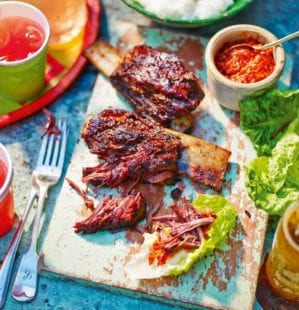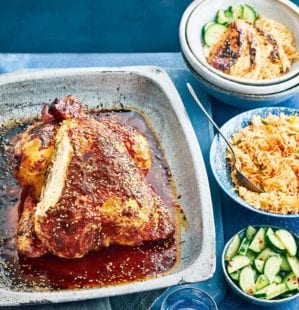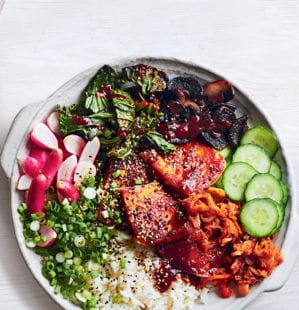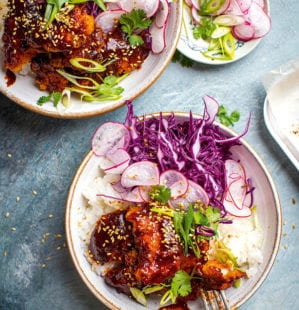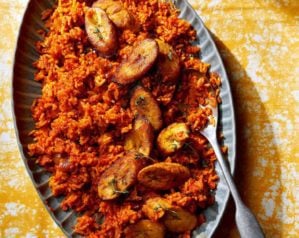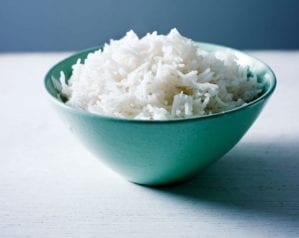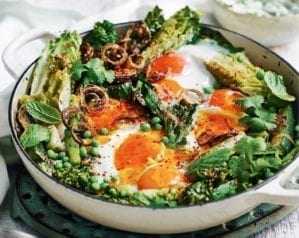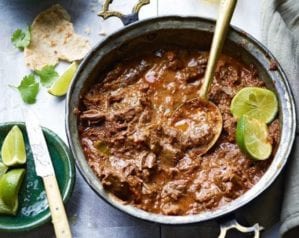
Bibimbap
- Published: 30 Mar 23
- Updated: 25 Mar 24
Learn how to make the colourful Korean rice dish bibimbap with this masterclass recipe from Korean-born Londoner Su Scott. Top perfectly-cooked rice with an array of veg, a frilly fried egg, punchy gochujang paste and sesame oil to make this addictive Korean classic.
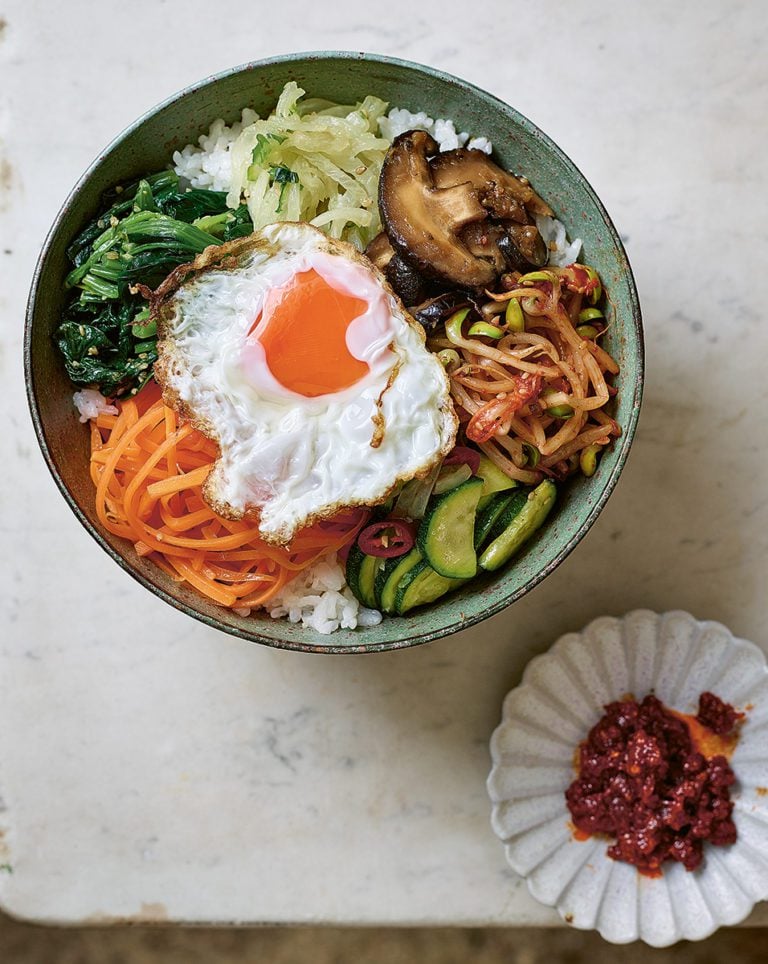
Have you tried our Korean fried chicken bowls yet?
Recipe taken from Rice Table: Korean Recipes and Stories to Feed the Soul by Su Scott (Quadrille £27).
Ingredients
- 300g freshly cooked shortgrain rice (Korean if you can find it) to serve
- Toasted sesame oil to drizzle
- 2 tbsp gochujang to serve
For the mushrooms
- 4 dried shiitake mushrooms
- 1 tbsp light soy sauce
- 2 tsp mirin
- ½ tsp golden granulated sugar
- ¼ tsp ground black pepper
- 1 garlic clove, finely chopped
- 1 tsp toasted sesame oil
- ½ tbsp vegetable oil
For the carrots
- 1 tbsp extra-virgin olive oil
- 200g carrots, cut into matchsticks (a julienne peeler is useful here)
- 1 tbsp mirin
- 1 tbsp rice wine vinegar
For the eggs
- 3 tbsp extra-virgin olive oil
- 2 medium free-range eggs
Optional extras
- Beansprouts
- Sautéed courgettes or radishes, wilted spinach… whatever needs using up in the fridge
Method
- For the mushrooms, put the shiitake in a heatproof bowl and cover with boiling water. Set aside for 20 minutes to rehydrate. Squeeze the excess water out (reserve it), then finely slice the mushrooms, including the stalks, and put in a small bowl. Add the soy sauce, mirin, sugar, pepper, garlic and sesame oil. Let them marinate for 10 minutes or so while you cook the carrots.
- For the carrots, heat the oil in a pan over a medium heat. Add the carrots and cook gently for a few minutes with a good pinch of salt. You should notice the tint of deep orangey yellow seeping into the oil and smelling quite fragrant. Remove from the heat when the carrots have softened. Transfer to a bowl while hot. Add the mirin and vinegar, combine well and cover the bowl with a plate to let the carrots steam further and marinate in the residual heat.
- Return to the mushrooms. Heat the vegetable oil in the same pan you fried the carrots in, over a medium heat. Add the marinated mushrooms to the pan and cook gently for 2 minutes. You’ll notice the smell of garlic and sweet soy sauce. Add 3 tbsp of the mushroom soaking water to the pan. Let it come to a gentle bubble, then lower the heat. Simmer for 10 minutes or until the mushrooms have absorbed all the liquid. Taste for seasoning and remove from the heat.
- To fry the eggs, heat the olive oil in a frying pan for a few minutes over a medium heat. Crack the eggs in, ensuring they are not too close. Let them fry for 2 minutes without touching, then tilt the pan slightly away from you to pool the oil and carefully baste around the whites that still appear raw. Keep the yolks nice and runny.
- To serve, divide the warm rice between individual bowls. Arrange the mushrooms, carrots (and any other vegetables) on top, along with the fried eggs. Top with a drizzle of sesame oil and serve with the gochujang.
- Recipe from April 2023 Issue
Nutrition
- Calories
- 693kcals
- Fat
- 38.5g (6.2g saturated)
- Protein
- 15.4g
- Carbohydrates
- 69.1g (12.2g sugars)
- Fibre
- 4.4g
- Salt
- 2g
delicious. tips
“Bibim translates as ‘to mix’ and bap means ‘cooked rice’. It’s essentially a rice bowl with toppings you mix to eat. It’s a well-known Korean dish, loved by all for its eye-catching visuals and deliciousness, and it happens to be incredibly nutritious, too.
At home, it’s not always an elaborate affair. Often, the dish is influenced by odds and ends of namul (seasoned vegetables) from banchan (side dishes) that need eating. It can be as simple as just one namul, thrown into a bowl with a gnarly fried egg with a runny yolk. All you need is a dollop of gochujang paste and a drizzle of toasted sesame oil to bind everything together. It can be as simple or as complex as you want it to be.”
Buy ingredients online
Rate & review
Rate
Reviews
Subscribe to our magazine
Food stories, skills and tested recipes, straight to your door... Enjoy 5 issues for just £5 with our special introductory offer.
Subscribe
Unleash your inner chef
Looking for inspiration? Receive the latest recipes with our newsletter

